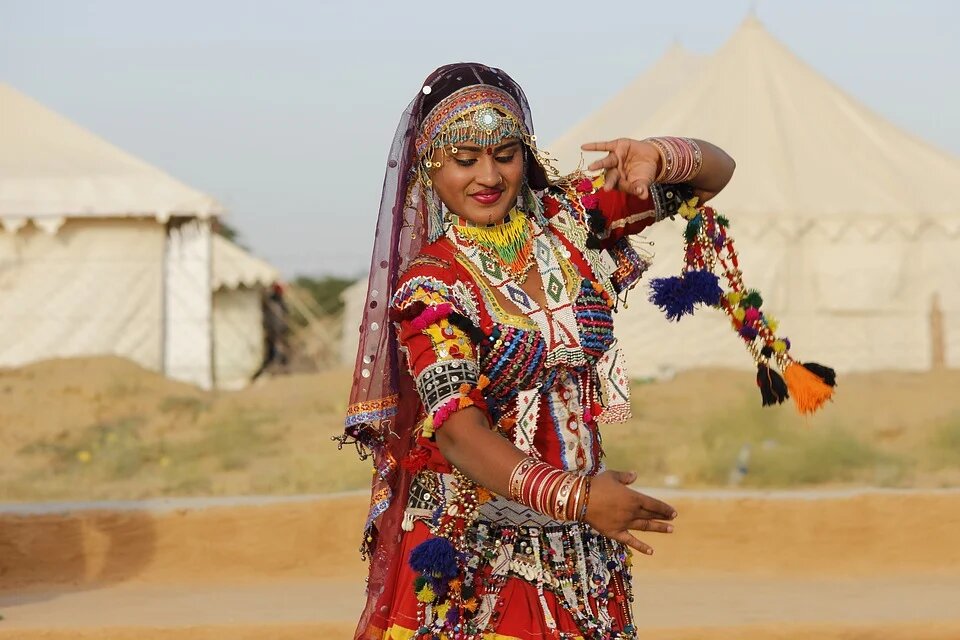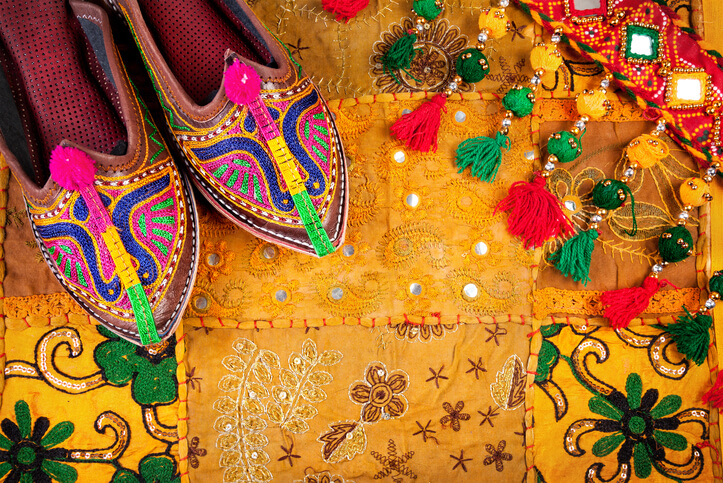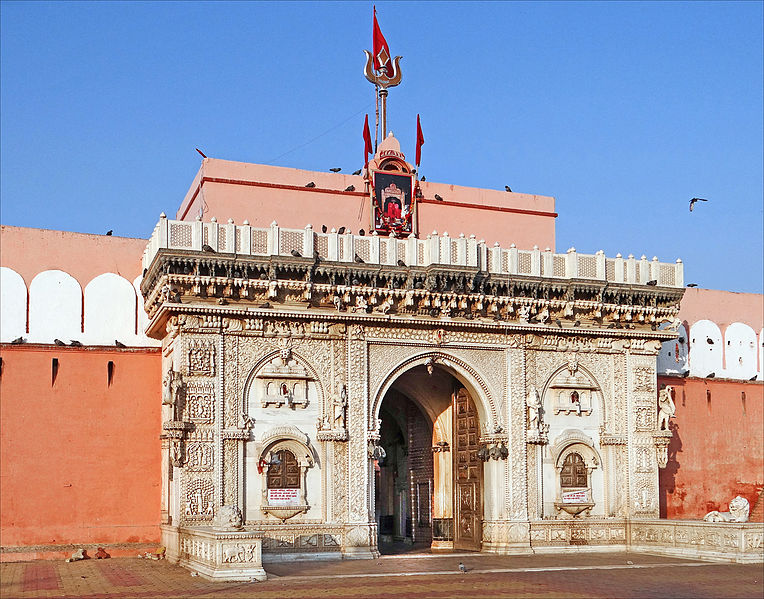Rajasthani culture dates back to the time when Rajasthan was the abode of the kings. Rajasthani culture and tradition have attracted people to explore the beautiful state, not just from India, but abroad as well.
Vibrant, opulent, and mesmerisingly beautiful are what spell out Rajasthani culture. Rajasthan, which means “the abode of kings”, gets its name from the many Rajput kings who ruled the state before British rule. Over centuries, Rajasthan has been ruled by various Rajput, Maratha, and even Muslim rulers, which has led to its diverse culture. The state is home to a colourful bouquet of awe-inspiring monuments, expansive forts, magical palaces, lively folk dances, alluring handicrafts, and some delectable delicacies that are unique only to Rajasthan.
Often called the cultural capital of India, Rajasthan’s culture, food, and dress (to name a few) have fascinated people from India and the rest of the world alike. “Its hospitality is known around the world and Rajasthan culture and art, along with other aspects, set it apart from the rest of the Indian states. Rajasthan tour packages cover the majority of the main cities and you can have an incredible experience.
Also read: 11 reasons to visit Rajasthan
11 Fascinating Aspects Of Rajasthani Culture That You Must Know
1. Rajasthani Cuisine

As Rajasthan is primarily a desert region, its cuisine has been heavily influenced by its geography. Ingredients and foods that had a shelf life of more than a few days, and could be eaten without heating, are preferred. Another reason for this is the fact that the inhabitants of Rajasthan frequently found themselves in war-like situations in the past.
To make sure their food had a longer shelf life, Rajasthanis loaded their dishes with oil or ghee (clarified butter) in order to preserve it. Due to the scarcity of water and fresh vegetables, dried spices play a huge role, and so Rajasthani cuisine is known to be very spicy. The Rajputs were also known to be fond of meat dishes, and so Rajasthan also has some very iconic meat-based dishes.
While spice plays a significant role in the state’s cuisine, Rajasthani culture is also big on sweet dishes and desserts. Most of their sweets are made with pure ghee which adds a distinct taste and aroma. Some of the most famous Rajasthani delicacies are daal baati churma, ghevar and laal maas.
Read more: 13 mouth-watering delicacies from Rajasthan you simply must try
2. Rajasthani Folk Dances

Rajasthani culture is famous for having a variety of folk dances that are attractive, vibrant, and a great form of entertainment. Some of these dance forms are even famous worldwide. Most of these folk dancers are highly skilled and their moves cannot be performed by just anyone. Two of the most popular dances are Kalbeliya and Ghoomar.
Kalbeliya is a popular dance form from Rajasthan performed by the tribe of the same name. The Kalbeliya tribe is known for being snake charmers and catchers. This connection to snakes can be found in their dance form as well. The women dancers dress up in embellished and flowing black skirts and perform intricate steps and swirls which appear to be graceful replications of a snake’s movements.
Ghoomar is a traditional folk dance performed by Rajasthani women on special occasions and festivities. The dance form gets its name from the word ghoomna, the Hindi word for ‘spinning’. It involves graceful gyrating movements which allow the dancers’ heavy and elaborate traditional skirts to flare out and display their colourful and intricate designs.
Read more: 11 Rajasthani folk dances you must witness
3. Rajasthani Music

Music has been an indispensable part of Rajasthan culture. Since it’s been home to a lot of tribal communities, tribal and folk music have always played an important role in the state. There are two prominent groups that contribute to Rajasthan folk music— the Manganiyars and the Langas. Primarily Muslim communities, the Langas stuck to Muslim audiences and styles, while the Manganiyarsfollowed a more liberal approach to music. Folk songs or ragas are sung for different purposes. For instance, there are different songs for different seasons and a specific raga for ushering in the monsoons as well.
Rajasthani folk songs are mostly about heroic tales and love stories, while others are devotional in nature. The dholak, sarangi, sitar and other traditional instruments give the music a euphoric and ethnic touch.
4. Rajasthani Attire
Attire is an important aspect of Rajasthani culture which reflects the opulent heritage of the Rajasthani people.
Traditional Attire For Rajasthani Women

Women usually wear a ghagra, choli, and odhni. The ghagra is a full-length embroidered skirt that comes in a variety of colours, prints and fabrics. Leheria, bandhej, and chundhri are some of the most well-known ghagra prints. The choli is the blouse worn with the ghagra. It is often embellished with mirrorwork, sequins, shells, and beads. The whole outfit is complete with the odhni, a long piece of a cloth/scarf is used to cover the head as a veil. It’s beautifully embroidered with embellished borders; one of the most famous techniques being gota-patti (a type of embroidery which uses the applique technique with gold or silver ribbons). This type of embroidery originated in Rajasthan.
Traditional Attire For Rajasthani Men

Men traditionally wear a dhoti and angarkha or kurta with pyjamas. The dhoti is a long piece of cloth tied around the waist and wrapped around the legs. The angarkha and kurta are upper-body wear. The angarkha was traditionally only worn by the elite class—the upper garment is characterised by an asymmetric opening which is knotted with thread ties. The kurta is a loose-fitted shirt and pyjamas are similar to loose track pants.
This traditional outfit remains incomplete without the pagdi (turban or headgear). It’s considered a symbol of pride and honour among Rajasthani men. It comes in a variety of shapes, sizes and colours. Some variants are meant for special occasions, while some are used for daily wear.
Footwear

Rajasthan is famous for its leather shoes, known as jootis. These are made of camel, sheep, or goat skin. The shoes are embellished with beautiful embroidery. While traditional jootis are brown or black, today they’re found in multiple colours and fashionable styles.
5. A Colour Coordinated State
Rajasthan is known for having beautifully colour-coordinated cities. No wonder it’s considered as one of the most vibrant colourful states of India. And each colour-coordinated city has a small piece of fascinating history attached to it:
Jaipur – The Pink City

Jaipur is famously known as the Pink City worldwide. In 1876, the city was painted terracotta pink to welcome the Prince of Wales and Queen Victoria. Subsequently, the ruler passed a law stating that all the buildings and houses in the city must be painted pink, which is still followed.
Also read: The top 13 places to not miss visiting in Jaipur
Jodhpur – The Blue City

The city is filled with beautiful blue-hued houses that remind one of the sea. Initially, it was a trend started by the elite class of Jodhpur. However, now it is a common trend followed by all. It is also said that painting the houses blue works as an insect repellent.
Udaipur – The White City

The first thing you notice in Udaipur is the plethora of beautiful lakes. The city is also full of pristine white buildings that reflect on the lakes’ surfaces beautifully. Back in the day, kings would build their palaces with white marble and so, most of the prime buildings in Udaipur are white.
Also read: Why Udaipur was not the picture perfect destination social media led me to believe
6. Rajasthani Architecture

Rajasthani architecture is influenced by the mixed variety of people that have stayed and ruled over the royal state. The architecture is seen to be a regional variant of the style prevalent across northern India. Most of the population in Rajasthan has primarily been Hindu, with a small number of Jains. The blend of these two religions has led to a lot of temples being built here.
Around the 11th century, a distinctive architectural style emerged in Rajasthan called Maru-Gurjar. This style is popular not only in Rajasthan but in the neighbouring state of Gujarat as well. The etymology behind the name relates to the ancient names of the two states, Marudesh for Rajasthan and Gurjaratra for Gujarat. The style is common amongst Hindu temple architecture but has also been popularised by Jain temples. A prime example is the Dilwara Jain Temple in Mount Abu. A telling feature of Maru-Gurjar architecture is that almost every surface is adorned with elaborate carvings.
Additionally, there are some distinct pieces of architecture commonly found across Rajasthan such as Baoris (step wells) and Chatris (cenotaph memorials).
Also read: Visit the top 9 most intricate Baolis or Baoris of India
7. Forts Of Rajasthan

When one thinks of Rajasthan, it is impossible not to associate it with the magnificent forts that reside in the state. With over a hundred fortifications on hills, six hill forts of Rajasthan have been clustered and given the United Nations Educational Scientific and Cultural Organisation (UNESCO) World Heritage Site status. The Six Hill Forts of Rajasthan are Chittor Fort at Chittorgarh, Kumbhalgarh Fort at Kumbhalgarh, Ranthambore Fort at Sawai Madhopur, Gagron Fort at Jhalawar, Amer Fort at Jaipur, Jaisalmer Fort at Jaisalmer.
8. Temples Of Rajasthan

There are numerous religious sites worth visiting in Rajasthan. Exploring them also provides insight into the state’s elaborate history and culture, local customs, beliefs, and traditions.
Brahma Mandir In Pushkar
Pushkar in Rajasthan has the only temple in India that is dedicated to lord Brahma. Although there are smaller temples dedicated to Brahma now, the one in Pushkar is the earliest and most prominent one. The story behind it tells us that when Brahma came down to earth, he named the place where the flower (“pushpa”) fell from his hand (“kar”)— leading to the name Pushkar. So, the people of Pushkar erected a temple to honour him. The temple is situated next to Pushkar Lake, considered to be a holy spot. It’s supposedly 2000 years old and attracts devotees from all over the country. They take a dip in the lake and offer prayers to lord Brahma at the temple.
Karni Mata Mandir In Deshnoke
Dedicated to Karni Mata, this temple is located in Deshnoke, which is nearly 30 km from Bikaner. It is one of the most unique religious sites in India as there are nearly 20,000 rats living in this temple. The rats are called kabbas and are worshipped by the devotees. The offerings made here are eaten by the rats and then given back as prasadam (blessed offering).
The legend goes that the temple was built in the 1400s and the goddess worshipped here, Karni Mata, is an incarnation of the goddess Durga. People believe that Karni Mata had asked Yama, the god of death, to reincarnate the son of a storyteller. When Yama refused, the goddess promised all the male storytellers that the members of their caste will all be reincarnated as rats in her temple.
Mehendipur Balaji Temple In Karauli
This temple in Karauli is dedicated to Lord Hanuman and is said to have healing powers. It is also believed that the temple can help in the exorcism of evil spirits. It is important to be cautious while visiting this temple, as its practices can prove to be disturbing, especially for small kids.
9. Rajasthani Art And Paintings

Rajasthan boasts a rich heritage of art and culture. The Rajput clan particularly has made hefty contributions to Rajasthani art and culture. Rajput paintings flourished in the 17th and 18th centuries when artists would paint elaborate scenes from the Hindu epics Ramayana and Mahabharata.
Rajasthani paintings were mainly meant to be kept in boxes or albums. Displaying the paintings was not a very common practice and hence, miniatures were the most preferred medium. However, paintings were also done inside the walls of the palaces, various havelis and other places of importance.
Gemstone paintings are very famous in Rajasthan. Originating in the Pink City, Jaipur, gemstone painting is created using semi-precious and precious stones like emeralds, rubies, and sapphires of different colours. The gemstones are ground to fine dust and then stuck to the sheet with the help of a pinhead point. This painting is entirely made by hand and hence, the artist’s skill and imagination are what bring out the vibrancy in these paintings. Since they’re made with all-natural stones, these paintings never fade and lose colour.
10. Rajasthani Handicrafts
Rajasthan is a treasure trove for people who love handicrafts. They are one of the most famous attractions of the state and an accurate reflection of the state’s rich cultural heritage. Rajasthani handicrafts are known for their exuberance of colour and culture. They also provide a wide variety of choices for taking back as souvenirs. While there is a plethora of handicrafts that Rajasthan offers, some are especially known as being quintessentially Rajasthan and are popular not just in India, but around the world as well –
Textile And Fabrics Of Rajasthan
Textiles are intrinsically connected to Rajasthani culture. Colours in unique hues and prints make up the fabrics from Rajasthan. These include different forms of block printing and tie and dye methods. Each place has its own distinct style and design—Sanganeri print Sanganer has bright colours in floral patterns. Jodhpur and Sikar are famous for their tie and dye techniques. Popular amongst the plethora of beautiful designs are—chunari (dotted), leheriya (wave-like diagonal patterns), and mothra (large dots). Bikaner and Jhunjhunu are popularly known for intricate mirror work and other appliqué used to embellish the fabric for Rajasthan’s traditional dresses.
Puppets

Puppets, also known as kathputli, with wooden heads and stuffed bodies, are iconic to the culture of Rajasthan. They are painted with arched eyebrows and moustaches for males while colourful faces with nose rings and large expressive eyes are painted on female puppets. The puppets are dressed in bright and vividly coloured clothes which are usually embellished with dazzling sequins. A popular form of entertainment in Rajasthan is the kathputli show where expert puppeteers put up a show with the puppets dancing to live music.
Pottery
The blue pottery of Jaipur is quite famous for reflecting the state’s culture and heritage. It is made out of ground quartz stone. The designs on the pottery are usually exquisite floral designs or animal prints.
It is a Persian art form which was first introduced in the state by Maharaja Ram Singh.
Jewellery

Rajasthani people are fond of adorning their attire with beautiful gems and so, Rajasthani culture includes beautiful jewellery as well. Each region of the state has its own style of jewellery. Jaipur is popular for gem cutting, silver ornaments, and coloured glass stones. The thewa pendants are made of inlaying gold with semi-precious stones and are famous worldwide. Bikaner is famous for kundan work, a traditional form of Indian gemstone jewellery which involves setting a gold foil between stones. This is usually done for elaborate necklaces.
11. Festivals Of Rajasthan

You cannot speak about Rajasthani culture without speaking of Rajasthan’s joyous and colourful festivals. They are as popular as their art, handicrafts, and architecture and are celebrated in full swing every year. Some are of religious importance, others celebrate ethnicity, some display the state and its heritage, and some are solely cultural events.
Teej
Teej is one of the most popular festivals of Rajasthan and is celebrated with grandeur, complete with traditional songs and dances. The festival is dedicated to the goddess Teej and her gold palanquin is taken across the city with decorated elephants, horses, and camels in a grand procession. The sweet dish ghewar is a special delicacy prepared especially for this festival.
Pushkar Camel Fair
The Pushkar Camel Fair is a traditional festival where thousands of camels are gathered for trade. The festival is one of its kind and is celebrated with music, dance, magic shows, acrobats, snake charmers, and carousel rides—a full-blown carnival amid majestic sand dunes. The key attractions include parades and beauty contests of camels which are decorated with various embellishments, hot-air balloon rides, moustache competitions among men with elaborately decorated moustaches, and a handicraft bazaar.
Mewar Festival
The Mewar Festival is celebrated to usher in spring and is celebrated in Udaipur with much pomp and show. It’s the world’s second Living Heritage Festival and one of the most popular fairs in Rajasthan. It is celebrated with folk music, dance, and food. Seminars on the preservation of city monuments are a key feature, along with musical shows, classical dance performances, food stalls hosted by professional chefs, and a magnificent display of fireworks.
Also read: 20 festivals in India you simply cannot miss
Can Rajasthan Be Considered The Cultural Capital Of India?
While Rajasthan may not be the official cultural capital of India, Rajasthani culture is definitely worth experiencing. It is the culture and heritage of the state that truly brings out its soul. Every aspect of Rajasthani culture is colourful, vibrant, and packed with loads of zeal. If you wish to be immersed in a culture where eating, dancing, and singing are as natural as breathing, then you must experience Rajasthani culture at least once in your life.


